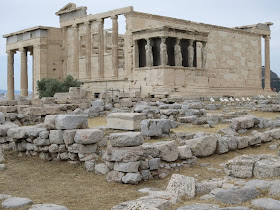 |
| The Erechtheion is an Ionic building, with its porches going in different directions. It commemorates the founding of Athens, with the contest between Athena and Poseidon |
 |
| One climbs the hill to get to the Propylaia, monumental gateway to the Acropolis. A wide opening in the center allowed horse-drawn chariots to enter. This view is from inside the hill. |
 |
| Although the Parthenon is Doric, this column on the ground was Ionic |
Yet, at any given time, so much on the Acropolis is in the process of restoration, covered up by scaffolds. I was there on the first day of June, which, unusually, was not a sunny day.
 |
| A view of the Acropolis ruins leads to another hill, capped Athens Tower |
Of course, the Parthenon is the best known, most beautiful and most perfectly proportioned of all Greek temples. Most of the building's west end was hidden from view, while I was there. From a few angles it's possible to see a good deal of its former glory.
 |
| East end of the Parthenon from inside of the Acropolis |
 |
| The pediment on the left side of the east end, the heads of horses pulling the chariot of the sun and a reclining god are visible. These plaster casts replace the Elgin marbles. |
However, there are plaster casts on the building, including sculpted horses and a reclining god (Dionysos or Heracles) on left side of the east pediment. These gives a great impression of how the the sculptures fit in under the roof. Replicas of the rest of the sculpture are on display at the New Acropolis Museum in Athens, completed in 2009. The museum's display reveals fairly well how the large sculptural program related to the architecture.
 |
| Above a triglyph is a horse's head on the opposite side of the pediment |
original square relief sculptures, called metopes, are actually in the Acropolis Museum.
One of these reliefs is particularly beautiful: Hebe and Hera, mother and daughter who sat among the gods and goddesses deciding the outcome of the Trojan War. Despite all the damage, the panel was recently restored. The drapery of the seated goddess, Hera, is so beautiful that we can sense the distinct folds of an undergarment as well as the outer clothing. Experts think that the Parthenon's chief sculptor, Phidias, did this panel.
 | ||
| The Metope of goddesses Hebe and Hera are among 4 metopes still in Athens |
There's so much more history of construction and destruction. The classical building of 442-432 is actually a replacement for the earlier temple to Athena which was burned by the Persians in 480 BC. Many fine statues of young women (kore, called korai, plural) and young men (kouros, called kouroi, plural), which were buried after the Persian pillage, are on display at the museum. Besides the elegant Peplos Kore, there are many other less famous votive statues of women from the Archaic period. Despite the archaic stiffness of many of these sculptures, they are extremely beautiful. I also appreciated the beauty of the relief statues of Nike (victory) figures from the balustrade which had surrounded the Temple of Athena Nike on the Acropolis, built after the Parthenon.
We can see more of the Erechtheion, an unusual temple formed with slender porches reaching out on three different sides. Because of its tall, Ionic columns and the Porch of the Maidens, I found the Erechtheion the most impressive of all buildings on the Acropolis. The caryatids are replacements for the original statues.
 |
| The Erechtheion is an Ionic temple. Its decorative details contrast with the simple Doric columns of the other structures |
 |
| A view behind the Porch of the Maidens over to the long side of the Parthenon reminds me that the Erechtheion stands over the stones of a giant Archaic temple, an earlier templet to Athena, |

Like the European Union, and majority of people polled in Great Britain, I think it would be best if the Elgin Marbles were returned to Athens, where they belong. It was 30 years ago when I saw them at the British Museum, and they were beautifully displayed to show the full beauty and genius in Phidias' design and execution. This new Acropolis Museum has the space for display.
ReplyDelete